Change Trend and Restoration Potential of Vegetation Net Primary Productivity in China over the Past 20 Years
Abstract
:1. Introduction
2. Materials and Methods
2.1. Study Area
2.2. Data and Processing
2.2.1. Meteorological Data
2.2.2. The NPP Data of MODIS
2.2.3. NPP Verification Data
2.2.4. Ecosystem Macro Structure Data
2.2.5. Nature Reserve Data
2.2.6. Ecological Geographic Area Data
2.3. Methods
2.3.1. Trend and Significance Test of NPP
2.3.2. Climax Background Vegetation NPP Simulation of Forest, Grassland and Desert Ecosystems
- (1)
- Multiyear mean meteorological and NPP data preparation. (1) The MAT and MTP of China from 2000 to 2019 were averaged and the 20-year and were obtained. (2) The China NPP data from 2017 to 2019 were averaged, and the 3-year average NPP data were averaged. The NPPavg values of the nature reserves were regarded as the climax background NPP.
- (2)
- ArcGIS software was used to obtain the ecogeographical zones, ecosystem types, MATavg, MTPavg and NPPavg of each point within the nature reserve. (1) ArcGIS’s ‘Raster To Point’ function was used to transfer the nature reserves in raster format NR to a vector point file . (2) We used the vector point file to extract the values of ecological geographic zones, nature reserves, , and data by the ArcGIS ‘Extract Multi Values To Points’ function, and obtained the vector point file . (3) The data’s attribute table contained each ecogeographical zone, ecosystem type, MATavg, MTPavg and NPPavg of each point.
- (3)
- Linear fitting of climax NPP and meteorological factors in nature reserves. (1) The attribute table of the data was exported to an Excel table file. (2) Taking NPPavg as the dependent variable and MATavg and MTPavg as the independent variables, 41 binary linear regression equations were fitted according to the ecogeographical zones and ecosystem type (Table 4), and each equation obtained three parameters , and , where i and j represent the parameters of ecosystem type j in the ecogeographical zone i.
- (4)
- According to the MATavg and MTPavg of China, the regression equations obtained by stage 3 were used to calculate the climax background vegetation NPP of China’s forest, grass and desert ecosystems. NPP was calculated as follows:where is the climax background vegetation NPP (gC/m2/a) of the ecosystem type j in the ecogeographical zone i; is the average temperature of China (°C); and is the average precipitation of China (mm). , and are the parameters of the linear regression equations of the ecosystem type j in the ecogeographical zone i. The obtained fitting equation, R2 and significance values are shown in the Table 4.
2.3.3. Restoration Potential of NPP Calculation of Forest, Grassland and Desert Ecosystems
2.3.4. Multiple Regression Residual Analysis
2.3.5. Uncertainty Estimation Approaches
3. Results and Analysis
3.1. MODIS-NPP Data Accuracy Verification
3.2. Spatial Patterns of Vegetation NPP
3.3. Change Trend of Vegetation NPP
3.4. Climax Background NPP of Forest, Grassland and Desert Ecosystems
3.5. Restoration Status and Restoration Potential NPP of Forest, Grassland and Desert Ecosystems
4. Discussion
4.1. Methodological Approaches and Uncertainty
- (1)
- The MODIS NPP product, partly due to the uncertainty in the default Biome- specified Parameters Look-Up Table (BPLUT) of the MODIS photosynthesis (PSN) model [71]. Parameter optimization is a promising method that can be used to calibrate uncertain parameters of the carbon cycle model.
- (2)
- Choice of zonal climax background. In the core areas of some nature reserves, such as LiboMaolan Nature Reserve, Jinggangshan Nature Reserve and other places, due to inconvenient transportation and small population, after years of strict protection, it can be considered that the vegetation condition is close to its zonal climax background. However, vegetation in nature reserves is not always in a climax state. For example, some nature reserves do not protect good natural ecosystems, only the ecological location may be important, but the reserve could still have damaged zones. Additionally, some nature reserves still have a certain degree of human disturbance due to inadequate management and other reasons. However, in nature reserves where overmature forests exist and in grassland nature reserves that have been enclosed for many years, the vegetation NPP is not maximised due to slowed or discontinued forest growth, or a lack of appropriate human disturbance [72,73]. Therefore, some indicators, such as biomass, can be added to characterise climax vegetation in future research [74].
- (3)
- Uncertainty of the simulation method. The regression analysis of climax vegetation status and natural factors is not only closely related to meteorological conditions such as precipitation and temperature, but also related to natural factors such as soil, vegetation and topography. Generally, adding the above natural factors for multiple regression will obtain a more accurate fitting equation, but when there are more natural factor combinations, the number of corresponding nature reserves will be fewer, which will affect the accuracy of the fitting equation. Therefore, choosing between these natural factors requires a weighing process.
4.2. Change Trend of Vegetation NPP and Its Classification
- (1)
- The areas with a significant increase in vegetation NPP were mainly distributed in the agro-pastoral zone, the Loess Plateau, the eastern Sichuan Basin and the Greater Khingan Range (p < 0.05). Ecological projects such as tree planting and afforestation in the abovementioned areas were the leading factors affecting the increase in NPP [80].
- (2)
- The areas with a relatively significant decrease in vegetation NPP were mainly distributed in the Qinghai-Tibet Plateau and Inner Mongolia Plateau. There were many grassland and desert ecosystems in these places. While ecological projects such as the Returning Rangeland to Grassland and the Grain for Green Program were also implemented, the change trend was not as obvious as that in the agro-pastoral zone due to natural factors such as high cold and drought.
- (3)
- The areas with a significant decrease in vegetation NPP were mainly distributed on the southern Qinghai-Tibet Plateau. The decrease in precipitation was also an important reason affecting the decrease in NPP. Human activities such as deforestation are more frequent in southern Tibet and have caused the extensive destruction of forests and other vegetation.
- (4)
- The Guangdong, Fujian, Yunnan and other places in the south (p < 0.05), and the decreasing trend in southern Tibet was the most significant; the decreasing trend in most areas was below −10 gC/m2/a2. Due to the rapid development of cities and industries in Guangdong, southern Jiangsu, Hainan Province and other places [17], the increase in atmospheric aerosol concentration has led to a decrease in solar radiation, which has led to a decrease in the effective photosynthetic radiation of vegetation [81], which was caused by a relatively significant decrease in vegetation NPP. On the Yunnan-Guizhou Plateau, the decrease in precipitation was also an important reason for the decrease in NPP (Figure 11b).
- (5)
- The areas that failed the significance test were mainly distributed in most areas of the western Qinghai-Tibet Plateau, southern Xinjiang, western Inner Mongolia and other places. The Gobi and deserts in these places were widely distributed, the surface was bare or the vegetation coverage was low and the vegetation NPP was almost 0, so there was no obvious trend for vegetation NPP. Additionally, some places, such as the central part of the North China Plain, were mainly farmland, and the types of crops were relatively fixed, so there was no obvious trend for vegetation NPP.
4.3. Climax Background Vegetation NPP of Forest, Grassland and Desert Ecosystems
4.4. Spatial Patterns of Vegetation NPP Restoration Potential
5. Conclusions
- (1)
- The change in China’s vegetation NPP showed a continuous upwards trend from 2000 to 2019. The two meteorological conditions, precipitation and temperature, contributed 85.41% to the change in vegetation NPP. It could meet the needs of the ecosystem’s climax background vegetation NPP simulation in nature reserves that were less affected by human activities.
- (2)
- The results obtained by the regression analysis method of meteorological conditions based on nature reserves reflected the zonal climax vegetation status to a large extent, and the obtained values had a smooth transition within each eco-geographical division and between each eco-geographical division, which truly reflected the law of gradual changes in climate, vegetation and natural conditions. The annual total climax background NPP of China’s forest, grassland and desert ecosystems was 2.76 ± 0.28 PgC, and the annual total NPP of the three ecosystems was 1.90 ± 0.2 PgC, 0.80 ± 0.07 PgC and 0.009 ± 0.0005 PgC, respectively. In future research, it is necessary to strengthen the acquisition of zonal climax background reference standards and try to select vegetation NPP in the core area of nature reserves and grassland enclosure areas that have been protected for many years.
- (3)
- Benefiting from the effective implementation of climate warming and humidification and ecological engineering, the agro-pastoral zone, the Loess Plateau, the eastern Sichuan Basin and the Greater Khingan Range had the most significant increase in the past 20 years. The total annual restoration status NPP in China’s forest, grassland and desert ecosystems was 2.24 PgC, and the total annual NPP of the three ecosystems was 1.54 PgC, 0.65 PgC and 0.007 PgC, respectively.
- (4)
- The annual total restoration potential NPP of China’s forest, grassland and desert ecosystems was approximately 0.52 ± 0.28 PgC, which accounted for approximately 19.05% of the total annual climax background NPP. The annual total restoration potential NPP of the forest, grassland and desert ecosystems was 0.36 ± 0.2 PgC, 0.16 ± 0.07 PgC and 0.002 ± 0.0005 PgC, respectively; additionally, the restoration potential accounted for 18.80%, 9.67% and 23.95% of the climax background NPP, respectively. The deployment of ecological projects should fully consider the restrictive climate conditions for decision makers and ecological assessment scholars, and the benefits and costs of the projects should be considered comprehensively.
Author Contributions
Funding
Institutional Review Board Statement
Informed Consent Statement
Data Availability Statement
Conflicts of Interest
References
- Cao, M.; Woodward, I.F. Dynamic responses of terrestrial ecosystem carbon cycling to global climate change. Nature 1998, 393, 249–252. [Google Scholar] [CrossRef]
- Leimbach, M.; Giannousakis, A. Burden sharing of climate change mitigation: Global and regional challenges under shared socio-economic pathways. Clim. Chang. 2019, 155, 273–291. [Google Scholar] [CrossRef]
- Nemani, R.R.; Keeling, C.D.; Hashimoto, H.; Jolly, W.M.; Piper, S.C. Climate-Driven Increases in Global Terrestrial Net Primary Production from 1982 to 1999. Science 2003, 300, 1560–1563. [Google Scholar] [CrossRef] [PubMed] [Green Version]
- Sun, Q.L.; Li, B.L.; Li, F.; Zhang, Z.J.; Ding, L.L.; Zhang, T.; Xu, L.L. Review on the estimation of net primary productivity of vegetation in the Three-River Headwater Region, China. Acta Geogr. Sin. 2016, 71, 1596–1612. (In Chinese) [Google Scholar]
- Wang, J.; Dong, J.; Yi, Y.; Lu, G.; Oyler, J.; Smith, W.K.; Zhao, M.; Liu, J.; Running, S. Decreasing net primary production due to drought and slight decreases in solar radiation in China from 2000 to 2012. J. Geophys. Res-Biogeo. 2017, 122, 261–278. [Google Scholar] [CrossRef] [Green Version]
- Piao, S.L.; Fang, J.Y.; Guo, Q.H. Application of CASA model to the estimation of Chinese terrestrial net primary productivity. Acta Phytoecol. Sin. 2001, 25, 603–608. (In Chinese) [Google Scholar]
- Zhou, W.; Mu, F.Y.; Gang, C.C.; Guan, D.J.; He, J.F.; Li, J.L. Spatio-temporal dynamics of grassland net primary productivity and their relationship with climatic factors from 1982 to 2010 in China. Acta Ecol. Sin. 2017, 37, 4335–4345. (In Chinese) [Google Scholar]
- Li, G.C. Estimation of Chinese Terrestrial Net Primary Production Using LUE Model and MODIS Data; Graduate School of Chinese Academy of Sciences: Bejing, China, 2004. (In Chinese) [Google Scholar]
- Wang, J.B. Chinese Terrestrial Ecosystem Productive Model Applied Remote Sensing Data; Zhejiang University: Hangzhou, China, 2004. (In Chinese) [Google Scholar]
- Yuan, W.P.; Cai, W.W.; Liu, D.; Dong, W.J. Satellite-based vegetation production models of terrestrial ecosystem: An overview. Adv. Earth Sci. 2014, 29, 541–550. (In Chinese) [Google Scholar]
- Fang, J.Y.; Chen, A.P.; Peng, C.H.; Zhao, S.Q.; Ci, L.J. Changes in Forest Biomass Carbon Storage in China Between 1949 and 1998. Science 2001, 292, 2320–2322. [Google Scholar] [CrossRef]
- Liu, G.; Sun, R.; Xiao, Z.Q.; Cui, T.X. Analysis of spatial and temporal variation of net primary productivity and climate controls in China from 2001 to 2014. Acta Ecol. Sin. 2017, 37, 4936–4945. (In Chinese) [Google Scholar]
- Yuan, Q.Z.; Wu, S.H.; Zhao, D.S.; Dai, E.F.; Chen, L.; Zhang, L. Modeling net primary productivity of the terrestrial ecosystem in China from 1961 to 2005. J. Geogr. Sci. 2013, 24, 3–17. [Google Scholar] [CrossRef]
- Zhu, W.Q.; Pan, Y.Z.; Yang, X.Q.; Song, B.G. Analysis of the Impact of Climate Change on China’s Terrestrial Vegetation Net Primary Productivity. Chin. Sci. Bull. 2007, 52, 2535–2541. (In Chinese) [Google Scholar] [CrossRef]
- Zhao, M.M.; Liu, Y.; Yang, J.L.; Liu, Y.; Zhao, N.; Yue, T.X. Spatio-temporal patterns of NPP and its relations to climate in China based on HASM. Ecol. Environ. Sci. 2019, 28, 215–225. (In Chinese) [Google Scholar]
- Chen, Y.; Feng, X.; Tian, H.; Wu, X.; Gao, Z.; Feng, Y.; Piao, S.; Lv, N.; Pan, N.; Fu, B. Accelerated increase in vegetation carbon sequestration in China after 2010: A turning point resulting from climate and human interaction. Glob. Chang. Biol. 2021, 27, 5848–5864. [Google Scholar] [CrossRef] [PubMed]
- Hou, Y.Y.; Mao, L.X.; Li, C.S.; Qian, S. Spatio-temporal pattern of vegetation net primary productivity changes in China. Chin. J. Ecol. 2008, 27, 1455–1460. (In Chinese) [Google Scholar]
- Huang, L.; Cao, W.; Xu, X.L.; Fan, J.W.; Wang, J.B. The Ecological Effects of Ecological Security Barrier Protection and Construction Project in Tibet Plateau. J. Nat. Resour. 2018, 33, 398–411. (In Chinese) [Google Scholar]
- Shao, Q.Q.; Fan, J.W.; Liu, J.Y.; Huang, L.; Cao, W.; Xu, X.L.; Ge, J.S.; Wu, D.; Li, Z.Q.; Gong, G.L.; et al. Assessment on the effects of the first-stage ecological conservation and restoration project in Sanjiangyuan region. Acta Geogr. Sin. 2016, 71, 3–20. (In Chinese) [Google Scholar]
- Liu, F.; Zeng, Y.N. Spatial-temporal change in vegetation Net Primary Productivity and its response to climate and human activities in Qinghai Plateau in the past 16 years. Acta Ecol. Sin. 2019, 39, 1528–1540. (In Chinese) [Google Scholar]
- Sun, H.L.; Zheng, D.; Yao, T.D.; Zhang, Y.L. Protection and Construction of the National Ecological Security Shelter Zone on Tibetan Plateau. Acta Geogr. Sin. 2012, 67, 3–12. (In Chinese) [Google Scholar]
- Tang, Y.Z.; Shao, Q.Q.; Liu, J.Y.; Zhang, H.Y.; Yang, F.; Cao, W.; Wu, D.; Gong, G.L. Did Ecological Restoration Hit Its Mark? Monitoring and Assessing Ecological Changes in the Grain for Green Program Region Using Multi-Source Satellite Images. Remote Sens. 2019, 11, 358. [Google Scholar] [CrossRef] [Green Version]
- Shao, Q.Q.; Fan, J.W.; Liu, J.Y.; Huang, L.; Cao, W.; Liu, L.L. Target-based Assessment on Effects of First-stage Ecological Conservation and Restoration Project in Three-river Source Region, China and Policy Recommendations. Bull. Chin. Acad. Sci. 2017, 32, 35–44. (In Chinese) [Google Scholar]
- Huang, L.; Zhu, P.; Xiao, T.; Cao, W.; Gong, G.L. The Sand Fixation Effects of Three-North Shelter Forest Program in Recent 35 Years. Sci. Geogr. Sin. 2018, 38, 600–609. (In Chinese) [Google Scholar]
- Zhang, B.; Wang, S.; Li, Q.X.; Xie, G.D. Spatio-temporal changes of water conservation service in the Beijing-Tianjin sandstorm source control project area. Acta Ecol. Sin. 2021, 41, 7530–7541. (In Chinese) [Google Scholar]
- Zhao, G.J.; Mu, X.M.; Tian, P.; Gao, P.; Sun, W.Y.; Xu, W.L. Prediction of vegetation variation and vegetation restoration potential in the Loess Plateau. J. Soil Water Conserv. 2021, 35, 205–212. (In Chinese) [Google Scholar]
- He, N.P.; Xu, L.; He, H.L. The methods of evaluation ecosystem quality: Ideal reference and key parameters. Acta Ecol. Sin. 2020, 40, 1877–1886. (In Chinese) [Google Scholar]
- Guo, R.; Wang, X.K.; Lu, F.; Duan, X.N.; Ouyang, Z.Y. Soil carbon sequestration and its potential by grassland ecosystems in China. Acta Ecol. Sin. 2008, 28, 862–867. (In Chinese) [Google Scholar]
- Duan, X.N.; Wang, X.K.; Lu, F.; Outyang, Z.Y. Carbon sequestration and its potential by wetland ecosystems in China. Acta Ecol. Sin. 2008, 28, 463–469. (In Chinese) [Google Scholar]
- Liu, Y.C.; Wang, Q.F.; Yu, G.R.; Zhu, X.J.; Zhan, X.Y.; Guo, Q.; Yang, H.; Li, S.G.; Hu, Z.M. Ecosystems carbon storage and carbon sequestration potential of two main tree species for the Grain for Green Project on China’s hilly Loess Plateau. Acta Ecol. Sin. 2011, 31, 4277–4286. (In Chinese) [Google Scholar]
- Zhang, J.; Li, J.P.; Wang, Y.T.; Zhang, Y.; Jing, L.; Li, J.P. Climate change in arid regions of Northwest China and its impact on potential grassland productivity. Ecol. Sci. 2020, 39, 182–192. (In Chinese) [Google Scholar]
- Xue, D.Y.; Jiang, M.K. Research on the Classification Standards of Types of Nature Reserves in China. China Environ. Sci. 1994, 4, 246–251. (In Chinese) [Google Scholar]
- Zhu, P.; Huang, L.; Xiao, T.; Wang, J.B. Dynamic changes of habitats in China’s typical nature reserves on spatial and temporal scales. Acta Geogr. Sin. 2018, 73, 92–103. (In Chinese) [Google Scholar] [CrossRef] [Green Version]
- Wang, X.; Ta, K.; Chen, B.; Du, P. Assessing the Spatiotemporal Variation and Impact Factors of Net Primary Productivity in China. Sci Rep. 2017, 7, 44415. [Google Scholar] [CrossRef] [PubMed] [Green Version]
- Gong, S.H.; Xiao, Y.; Zhang, L.; Ouyang, Z.Y. Driving forces and their effects on water conservation services in forest ecosystems in China. Chin. Geogr. Sci. 2017, 27, 216–228. [Google Scholar] [CrossRef] [Green Version]
- Liu, J.Y.; Kuang, W.H.; Zhang, Z.X.; Xu, X.L.; Qin, Y.W.; Ning, J.; Zhou, W.C.; Zhang, S.W.; Li, R.D.; Yan, C.Z.; et al. Spatiotemporal characteristics, patterns and causes of land use changes in China since the late 1980s. Acta Geogr. Sin. 2014, 69, 3–14. (In Chinese) [Google Scholar] [CrossRef]
- Liu, J.Y.; Ning, J.; Kuang, W.H.; Xu, X.L.; Yang, C.Z.; Li, R.D.; Chi, W.F.; Wu, S.X.; Hu, Y.F.; Pan, T.; et al. Spatio-temporal patterns and characteristics of land-use change in China during 2010–2015. Acta Geogr. Sin. 2018, 73, 789–802. (In Chinese) [Google Scholar]
- He, H.J.; Shi, X.L. Spatio-Temporal Characteristics of Land Cover Changes in China During 1990–2010. J. Geo. Info. Sci. 2015, 17, 1323–1342. (In Chinese) [Google Scholar]
- National Meteorological Information Center. Daily Meteorological Dataset of Basic Meteorological Elements of China National Surface Weather Station (V3.0) (1951–2010). 2019. Available online: http://data.cma.cn (accessed on 24 December 2021).
- Liu, Z.H.; Tim, R.V.; Li, L.T.; Tom, G.N.; Yang, Q.K.; Li, R.; Mu, X.M. Interpolation for time series of meteorological variables using ANUSPLIN. J. Northwest Sci-Tech Univ. Agric. For. 2008, 36, 227–234. (In Chinese) [Google Scholar]
- Hutchinson, T.X. Anusplin Version 4.4 User Guide; The Australian National University: Canberra, Australia, 2013. [Google Scholar]
- Guo, B.B.; Zhang, J.; Meng, X.Y.; Xu, T.B.; Song, Y.Y. Long-term spatio-temporal precipitation variations in China with precipitation surface interpolated by ANUSPLIN. Sci. Rep. 2020, 10, 1–17. [Google Scholar] [CrossRef]
- Hutchinson, M.F. Interpolating mean rainfall using thin plate smoothing splines. Int. J. Geogr. Inf. Syst. 1995, 9, 385–403. [Google Scholar] [CrossRef]
- Running, S.; Zhao, M. MOD17A3HGF MODIS/Terra Net Primary Production Gap-Filled Yearly L4 Global 500 m SIN Grid V006. 2019. Available online: https://lpdaac.usgs.gov/products/mod17a3hgfv006/ (accessed on 1 December 2021).
- Berrick, S. Data Processing Levels [EB/OL]. 2021[2021.1.13]. Available online: https://earthdata.nasa.gov/collaborate/open-data-services-and-software/data-information-policy/data-levels (accessed on 24 December 2021).
- Fan, J.W.; Shao, Q.Q.; Liu, J.Y.; Wang, J.B.; Chen, Z.Q.; Zhong, H.P.; Xu, X.L.; Liu, R.G. Dynamic Changes of Grassland Yield in Three River Headwater Region from 1988 to 2005. Acta Agrestia Sin. 2010, 18, 5–10. (In Chinese) [Google Scholar]
- Zhang, H.Y.; Fan, J.W.; Cao, W.; Zhong, H.P.; Harris, W.; Gong, G.L.; Zhang, Y.X. Changes in multiple ecosystem services between 2000 and 2013 and their driving factors in the Grazing Withdrawal Program, China. Ecol. Eng. 2018, 116, 67–79. [Google Scholar] [CrossRef]
- He, H.L.; Ge, R.; Ren, X.L.; Zhang, L.; Chang, Q.Q.; Xu, Q.; Zhou, G.Y.; Xie, Z.Q.; Wang, S.L.; Wang, H.M.; et al. Reference carbon cycle dataset for typical Chinese forests via colocated observations and data assimilation. Sci. Data. 2021, 8, 1–13. [Google Scholar] [CrossRef] [PubMed]
- Liu, G.R. Protocols for Standard Atmosphere Environmental Observation and Measurement in Terrestrial Ecosystems. China Environmental Science Press: Beijing, China, 2007. [Google Scholar]
- Yuan, G.; Tang, D.; Sun, X. Protocols for Standard Water Observation and Measurement in Terrestrial Ecosystems; China Environmental Science Press: Beijing, China, 2007. [Google Scholar]
- Luo, Y.J.; Wang, X.K.; Lu, F. Comprehensive Database of Biomass Regressions for China’S Tree Species; China Forestry Publishing House: Bejing, China, 2015. [Google Scholar]
- Liu, J.Y.; Xu, X.L.; Shao, Q.Q. The Spatial and Temporal Characteristics of Grassland Degradation in the Three-River Headwaters Region in Qinghai Province. Acta Geogr. Sin. 2008, 63, 363–376. (In Chinese) [Google Scholar]
- Xu, X.L.; Liu, J.Y.; Shao, Q.Q.; Fan, J.W. The dynamic changes of ecosystem spatial pattern and structure in the Three-River Headwaters region in Qinghai Province during recent 30 years. Geogr. Res. 2008, 27, 829–838. (In Chinese) [Google Scholar]
- Zheng, D. Research on China’s Ecological Geographical Region System; The Commercial Press: Bejing, China, 2008. (In Chinese) [Google Scholar]
- Sen, P.K. Estimates of the Regression Coefficient Based on Kendall’s Tau. J. Am. Stat. Assoc. 1968, 63, 1379–1389. [Google Scholar] [CrossRef]
- Yin, H.; Li, Z.G.; Wang, Y.L.; Cai, F. Assessment of Desertification Using Time Series Analysis of Hyper-temporal Vegetation Indicator in Inner Mongolia. Acta Geogr. Sin. 2011, 66, 653–661. (In Chinese) [Google Scholar]
- Long, Y.H.; Qin, J.X.; He, X.G.; Yang, Z. Wavelet multi-resolution analysis of vegetation dynamic change in Dongting Lake Basin. Acta Geogr. Sin. 2018, 70, 1491–1502. (In Chinese) [Google Scholar]
- Daneshvar, V.F.; Dinpashoh, Y.; Aalami, M.T.; Jhajharia, D. Trend analysis of groundwater using non-parametric methods (case study: Ardabil plain). Stoch. Environ. Res. Risk. A. 2012, 27, 547–559. [Google Scholar] [CrossRef]
- Wu, S.H.; Yin, Y.H.; Zheng, D.; Yang, Q.Y. Climate changes in the Tibetan Plateau during the last three decades. Acta Geogr. Sin. 2005, 60, 3–11. (In Chinese) [Google Scholar]
- Hamed, K.H.; Rao, A.R. A modified Mann-Kendall trend test for autocorrelated data. J. Hydrol. 1998, 204, 182–196. [Google Scholar] [CrossRef]
- Gocic, M.; Trajkovic, S. Analysis of changes in meteorological variables using Mann-Kendall and Sen’s slope estimator statistical tests in Serbia. Glob. Planet. Chang. 2013, 100, 172–182. [Google Scholar] [CrossRef]
- Wang, D.L.; Liu, W.P.; Huang, X.Y. Trend analysis in vegetation cover in Beijing based on Sen+Mann-Kendall method. Comput. Eng. Appl. 2013, 49, 13–17. (In Chinese) [Google Scholar]
- Jason, E.; Roland, G. Discrimination between climate and human- induced dryland degradation. J. Arid Environ. 2004, 57, 535–554. [Google Scholar]
- Pan, T.; Zou, X.T.; Liu, Y.J.; Wu, S.H.; He, G.M. Contributions of climatic and non-climatic drivers to grassland variations on the Tibetan Plateau. Ecol. Eng. 2017, 108, 307–317. [Google Scholar] [CrossRef]
- Jin, K.; Wang, F.; Han, J.Q.; Shi, S.Y.; Ding, W.B. Contribution of climatic change and human activities to vegetation NDVI change over China during 1982–2015. Acta Geogr. Sin. 2020, 75, 961–974. (In Chinese) [Google Scholar]
- Wu, C.; Munger, J.W.; Niu, Z.; Kuang, D. Comparison of multiple models for estimating gross primary production using MODIS and eddy covariance data in Harvard Forest. Remote Sens. Environ. 2010, 114, 2925–2939. [Google Scholar] [CrossRef]
- Friend, A.D.; Arneth, A.; Kiang, N.Y.; Lomas, M.; Oge, J.; Rodenbeck, C.; Running, S.W.; Santaren, J.D.; Sitch, S.; Viovy, N.; et al. FLUXNET and modelling the global carbon cycle. Glob. Chang. Biol. 2007, 13, 610–633. [Google Scholar] [CrossRef]
- Wu, C.; Chen, J.M.; Huang, N. Predicting gross primary production from the enhanced vegetation index and photosynthetically active radiation: Evaluation and calibration. Remote Sens. Environ. 2011, 115, 3424–3435. [Google Scholar] [CrossRef]
- Xu, X. Response of net primary productivity (NPP) of Sichuan vegetations to global climate changes. Chin. J. Ecol. 2004, 23, 19–24. (In Chinese) [Google Scholar]
- IPCC. Climate Change and Land: An IPCC Special Report on Climate Change, Desertification, Land Degradation, Sustainable Land Management, Food Security, and Greenhouse Gas Fluxes in Terrestrial Ecosystems; Shukla, P.R., Skea, J., Buendia, E.C., Masson-Delmotte, V., Pörtner, H.-O., Roberts, D.C., Zhai, P., Slade, R., Connors, S., van Diemen, R., et al., Eds.; IPCC: Geneva, Switzerland, 2019; in press. [Google Scholar]
- Huang, X.; Xiao, J.; Wang, X.; Ma, M. Improving the global MODIS GPP model by optimizing parameters with FLUXNET data. Agr. Forest Meteorol. 2021, 300, 108314–108327. [Google Scholar] [CrossRef]
- Xu, L.; Shi, Y.; Fang, H.; Zhou, G.; Xu, X.; Zhou, Y.; Tao, J.; Ji, B.; Xu, J.; Li, C.; et al. Vegetation carbon stocks driven by canopy density and forest age in subtropical forest ecosystems. Sci. Total Environ. 2018, 631, 619–626. [Google Scholar] [CrossRef] [PubMed]
- Zhang, H.; Fan, J.; Wang, J.; Cao, W.; Harris, W. Spatial and temporal variability of grassland yield and its response to climate change and anthropogenic activities on the Tibetan Plateau from 1988 to 2013. Ecol. Indic. 2018, 95, 141–151. [Google Scholar] [CrossRef]
- Assumma, V.; Bottero, M.; Monaco, R.; Soares, A.J. An integrated evaluation methodology to measure ecological and economic landscape states for territorial transformation scenarios: An application in Piedmont (Italy). Ecol. Indic. 2019, 105, 156–165. [Google Scholar] [CrossRef]
- Jiang, C.; Li, D.; Wang, D.; Zhang, L. Quantification and assessment of changes in ecosystem service in the Three-River Headwaters Region, China as a result of climate variability and land cover change. Ecol. Indic. 2016, 66, 199–211. [Google Scholar] [CrossRef]
- Zhao, D.S.; Gao, X.; Wu, S.H.; Zheng, D. Trend of climate variation in China from 1960 to 2018 based on natural regionalization. Adv. Earth Sci. 2020, 35, 750–760. (In Chinese) [Google Scholar]
- Peng, S.; Ding, Y.; Liu, W.; Li, Z. 1 km monthly temperature and precipitation dataset for China from 1901 to 2017. Earth Syst. Sci. Data 2019, 11, 1931–1946. [Google Scholar] [CrossRef] [Green Version]
- Chen, C.; Park, T.; Wang, X.; Piao, S.; Xu, B.; Chaturvedi, R.K.; Fuchs, R.; Brovkin, V.; Ciais, P.; Fensholt, R.; et al. China and India lead in greening of the world through land-use management. Nat. Sustain. 2019, 2, 122–129. [Google Scholar] [CrossRef]
- Piao, S.; Wang, X.; Park, T.; Chen, C.; Lian, X.; He, Y.; Bjerke, J.W.; Chen, A.; Ciais, P.; Tømmervik, H.; et al. Characteristics, drivers and feedbacks of global greening. Nat. Rev. Earth Environ. 2019, 1, 14–27. [Google Scholar] [CrossRef]
- Feng, X.M.; Fu, B.J.; Lu, N.; Zeng, Y.; Wu, B.F. How ecological restoration alters ecosystem services: An analysis of carbon sequestration in China’s Loess Plateau. Sci. Rep. 2013, 3, 2846. [Google Scholar] [CrossRef]
- Duan, J.; Mao, J.T. Study on the distribution and variation trends of atmospheric aerosol optical depth over the Yangze River Delta. Acta Sci. Circumstantiae 2007, 27, 537–543. (In Chinese) [Google Scholar]
- Burrell, A.L.; Evans, J.P.; Kauwe, M.G. Anthropogenic climate change has driven over 5 million km2 of drylands towards desertification. Nat. Commun. 2020, 11, 1–11. [Google Scholar] [CrossRef] [PubMed]

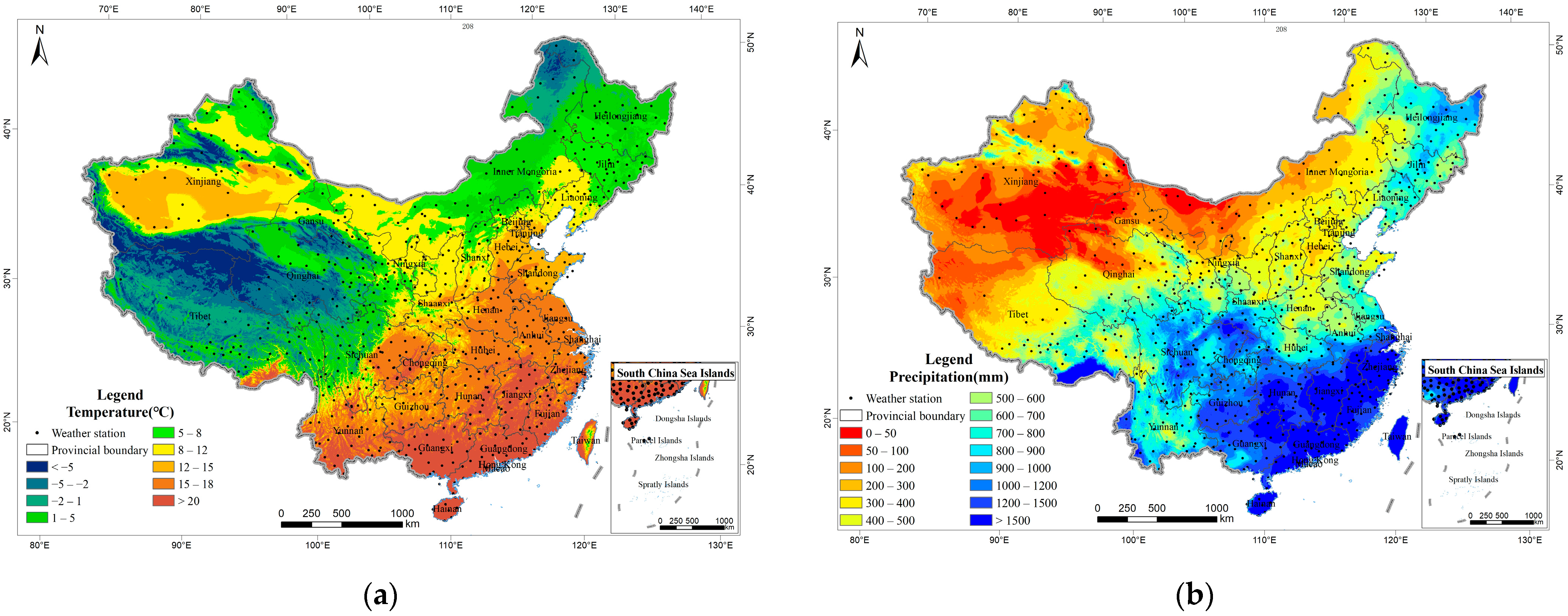


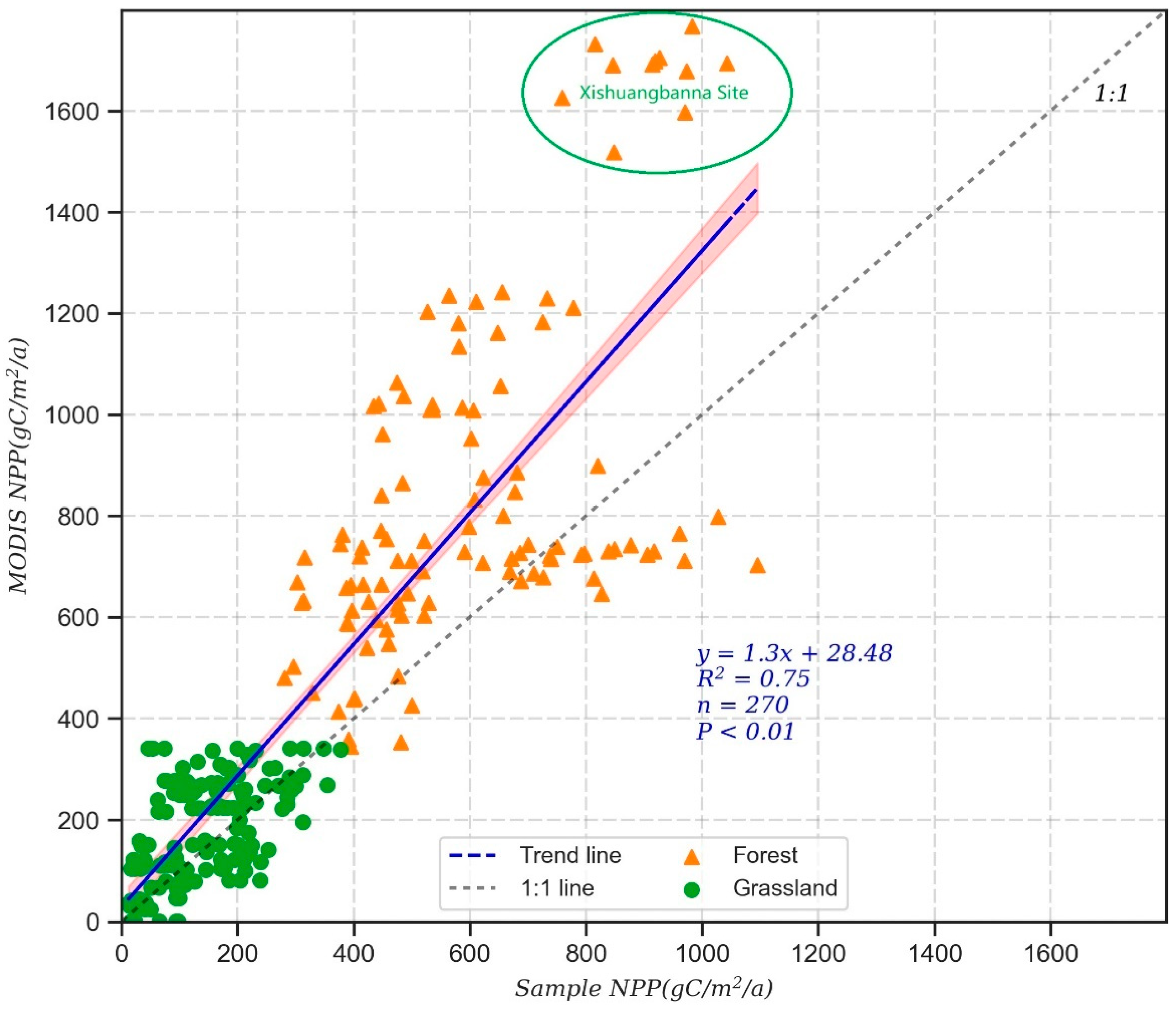
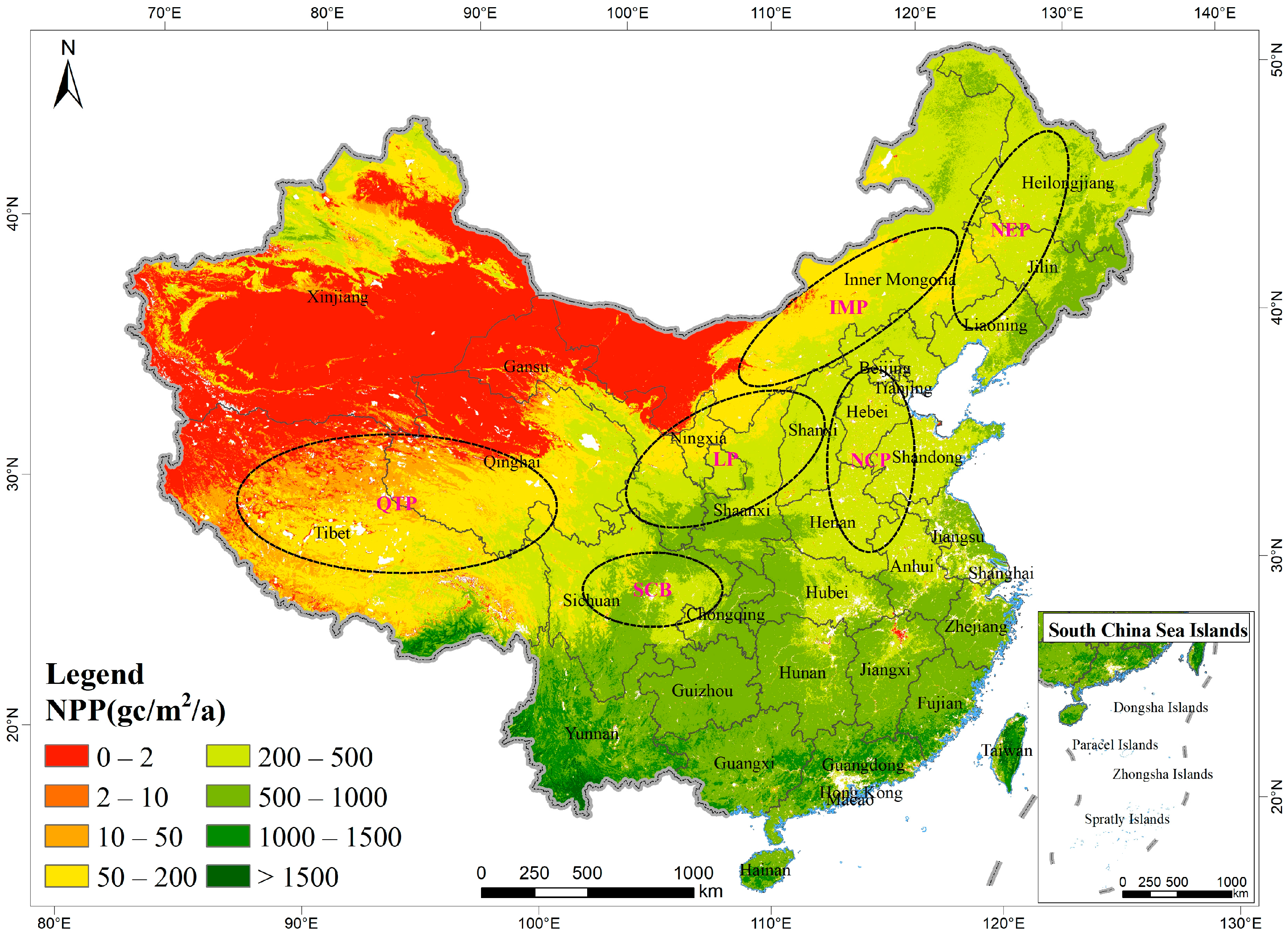
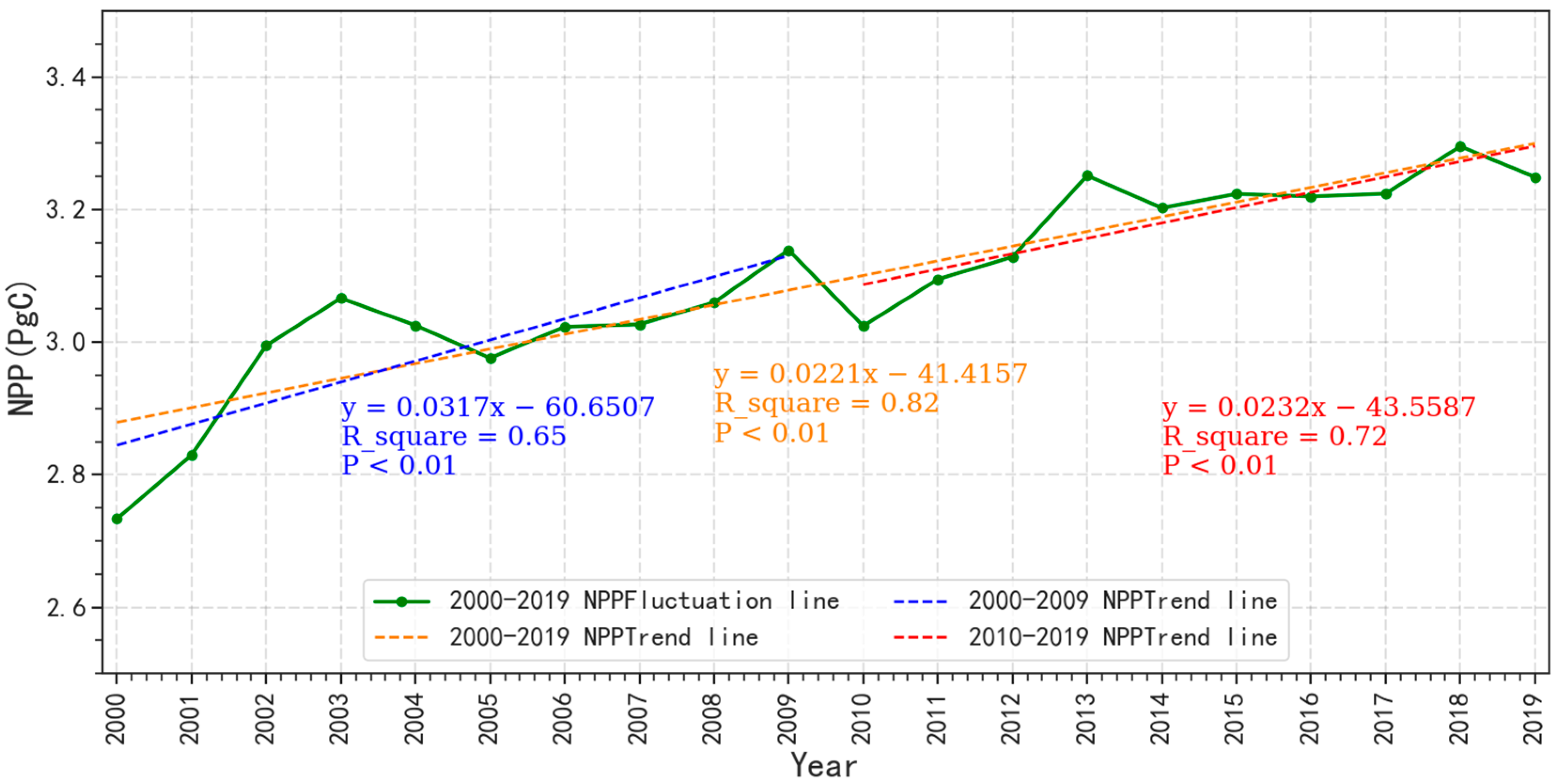
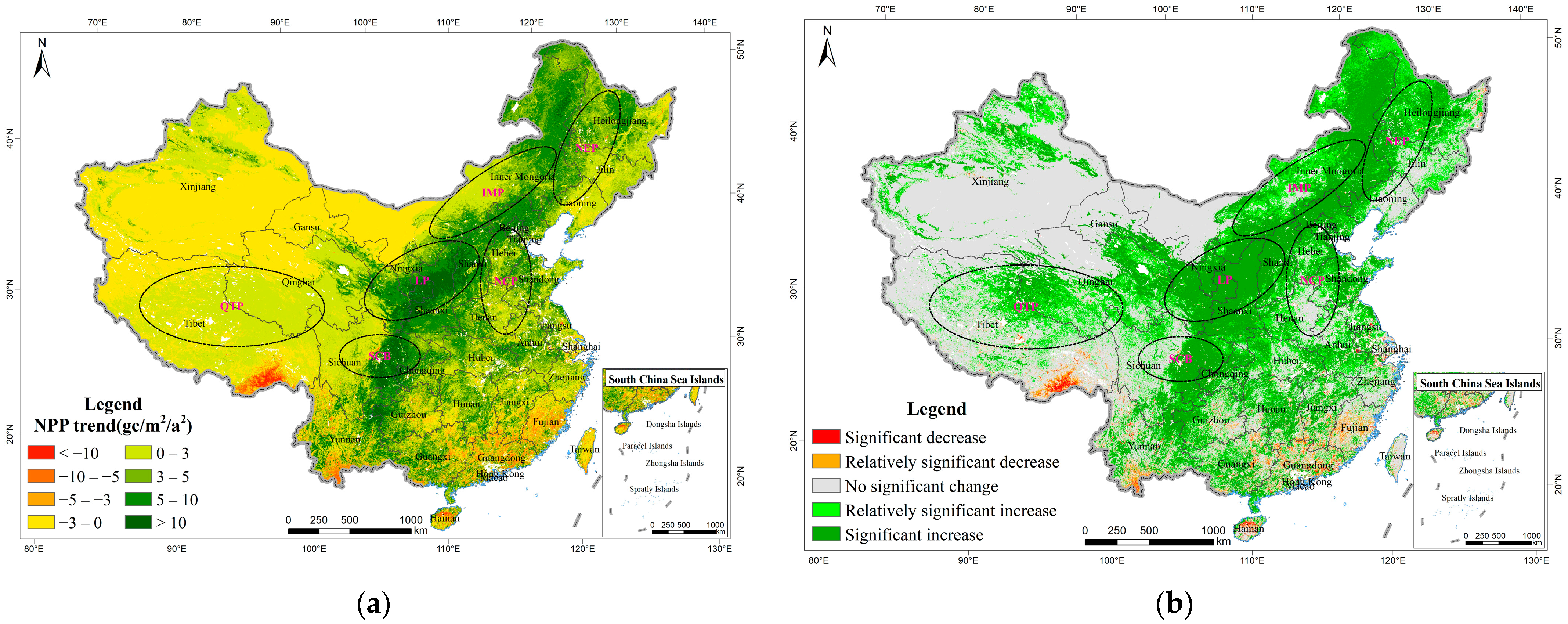
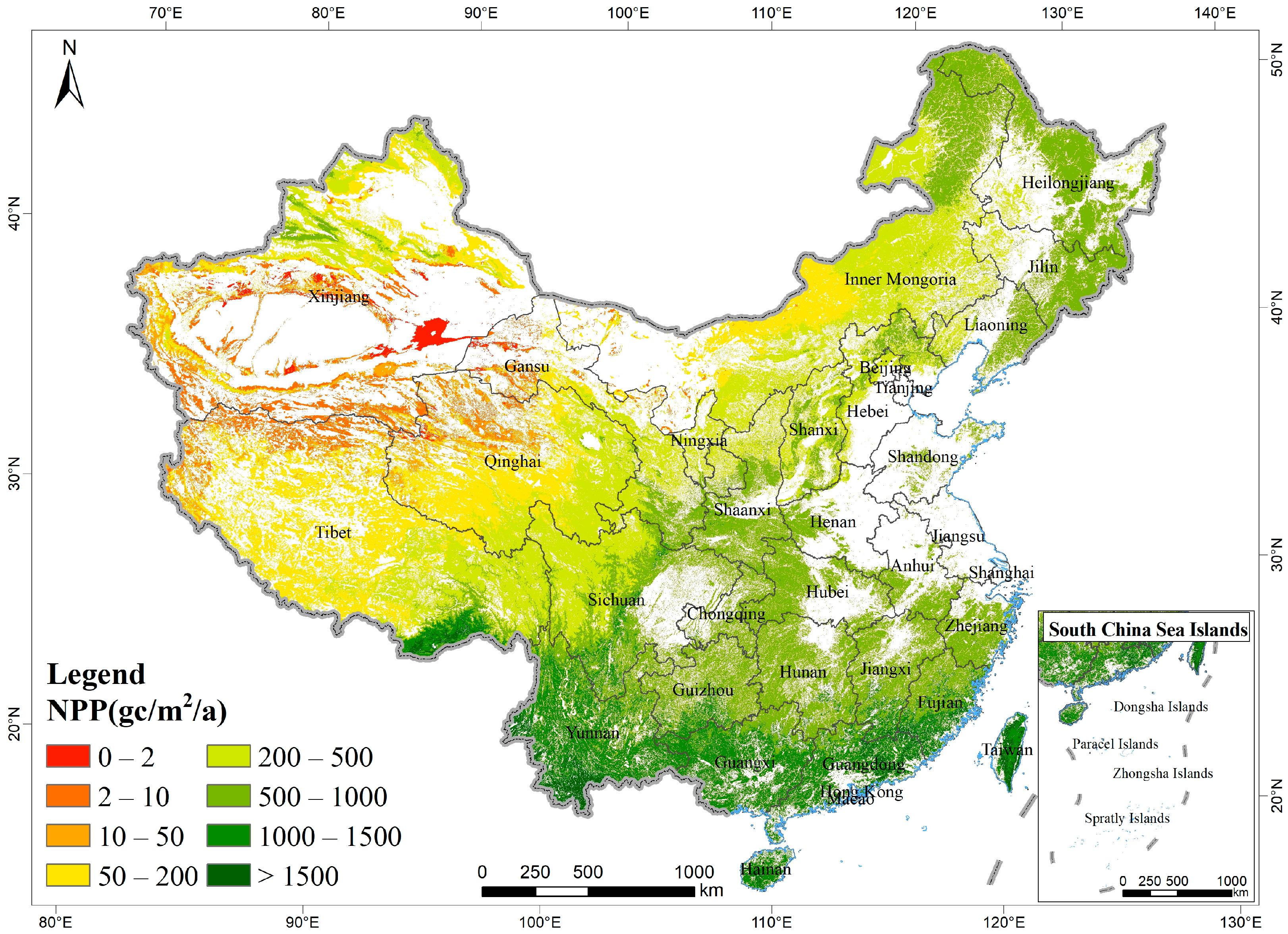

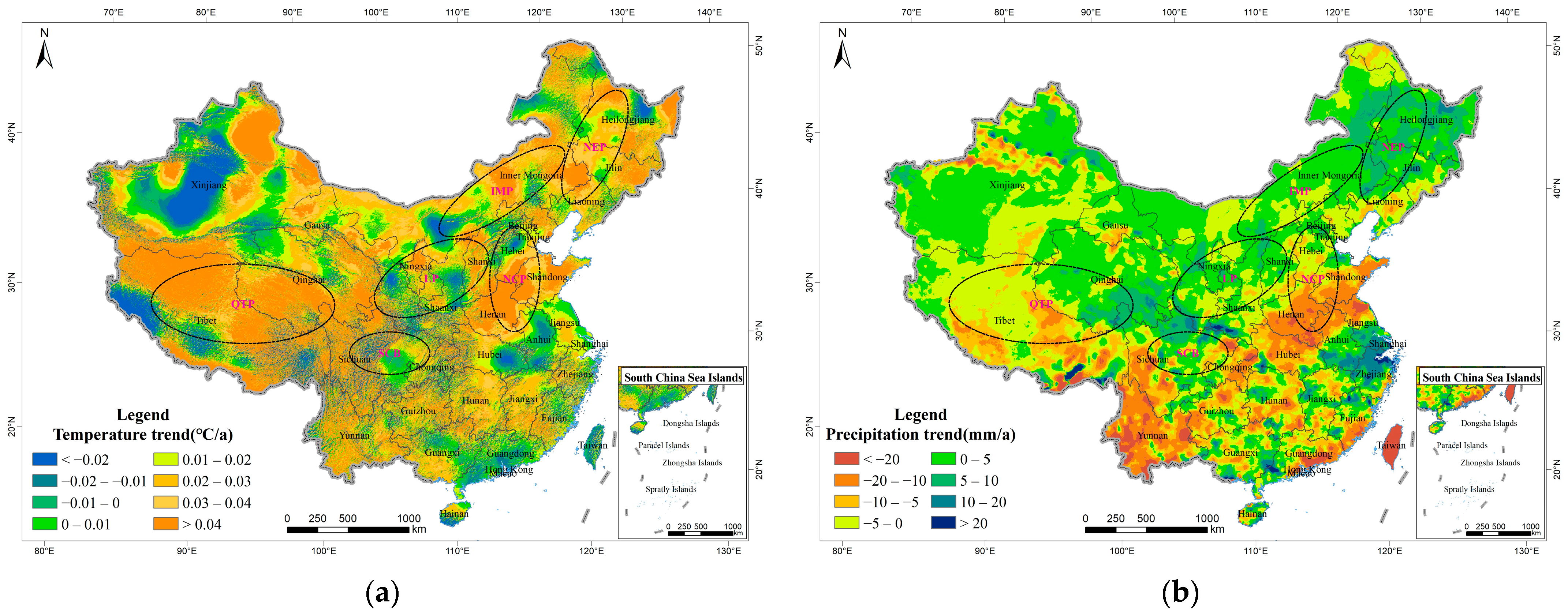
| Attribute | Value 1 |
|---|---|
| Protection levels | National (422), provincial (319), county (393) |
| Protection types | grassland meadows (6), geological relics (30), ancient biological relics (13), ocean coasts (24), desert ecology (17), inland wetlands (79), forest ecology (333), wetland ecology (3), wild animals (205) and wild plants (31) |
| Name | Abbreviation | Name | Abbreviation |
|---|---|---|---|
| Cold temperate humid zone | IA | Temperate arid zone of Qinghai-Tibet Plateau | HIID |
| Mid-temperate subhumid zone | IIA | Warm temperate humid zone | IIIA |
| Humid mid-temperate zone | IIB | Warm temperate subhumid zone | IIIB |
| Mid-temperate semiarid zone | IIC | Warm temperate semiarid zone | IIIC |
| Mid-temperate arid zone | IID | Warm temperate arid zone | IIID |
| Humid central subtropical zone | VA | Humid north subtropical zone | IVA |
| Sub-frigid and semiarid zone of Qinghai-Tibet Plateau | HIC | South subtropical humid zone | VIA |
| Frigid and Arid zone of the Qinghai-Tibet Plateau | HID | Marginal tropical humid zone | VIIA |
| Sub-frigid and subhumid zone of the Qinghai-Tibet Plateau | HIB | Humid mid-tropics zone | VIIIA |
| Humid and semi-humid temperate zone of the Qinghai-Tibet Plateau | HIIA-B | equatorial tropical humid zone | IXA |
| Temperate semiarid zone of Qinghai-Tibet Plateau | HIIC | - | - |
| Significance Types | Sen Trend Value | MK p Value |
|---|---|---|
| Significant decrease | <0 | p < 0.05 |
| Relatively significant decrease | <0 | 0.05 ≤ p ≤ 0.1 |
| No significant change | Valid range | 0.1 < p |
| Relatively significant increase | >0 | 0.05 ≤ p ≤ 0.1 |
| Significant increase | >0 | p < 0.05 |
| Code | Zone | Ecosystem | Fitting Equation | R2 | Significance |
|---|---|---|---|---|---|
| IIA | Mid-temperate subhumid zone | Forest | NPPavg = 128.52 + 12.54 × MATavg + 0.54 × MTPavg | 0.75 | p < 0.05 |
| grassland | NPPavg = 78.65 + 5.36 × MATavg + 0.37 × MTPavg | 0.81 | p < 0.05 | ||
| desert | NPPavg = −4.3 + 10.63 × MATavg + 0.32 × MTPavg | 0.85 | p < 0.05 | ||
| IIB | Humid mid-temperate zone | Forest | NPPavg = 379.37 + 12.82 × MATavg + 0.24 × MTPavg | 0.54 | p < 0.05 |
| grassland | NPPavg = 306.74 − 2.77 × MATavg + 0.24 × MTPavg | 0.59 | p < 0.05 | ||
| desert | NPPavg = 74.01 − 0.29 × MATavg + 0.34 × MTPavg | 0.73 | p < 0.05 | ||
| IIC | Mid-temperate semiarid zone | Forest | NPPavg = 57.56 + 25.12 × MATavg + 0.55 × MTPavg | 0.72 | p < 0.05 |
| grassland | NPPavg = 62.54 + 4.48 × MATavg + 0.53 × MTPavg | 0.83 | p < 0.05 | ||
| desert | NPPavg = −36.33 + 9.14 × MATavg + 0.46 × MTPavg | 0.89 | p < 0.05 | ||
| IID | Mid-temperate arid zone | Forest | NPPavg = 191.89 + 13.81 × MATavg + 0.28 × MTPavg | 0.73 | p < 0.05 |
| grassland | NPPavg = 69.89 + 9.1 × MATavg + 0.2 × MTPavg | 0.69 | p < 0.05 | ||
| desert | NPPavg = −8.28 + 1.23 × MATavg + 0.02 × MTPavg | 0.6 | p < 0.05 | ||
| IIA | Humid central subtropical zone | Forest | NPPavg = 333.68 + 35.71 × MATavg − 0.03 × MTPavg | 0.61 | p < 0.05 |
| grassland | NPPavg = 346.97 + 34.72 × MATavg − 0.03 × MTPavg | 0.49 | p = 0.1 | ||
| HIB | Sub-frigid and subhumid zone of the Qinghai-Tibet Plateau | Forest | NPPavg = 263.54 + 21.23 × MATavg − 0.04 × MTPavg | 0.66 | p < 0.05 |
| grassland | NPPavg = 235.78 + 19.4 × MATavg − 0.05 × MTPavg | 0.71 | p < 0.05 | ||
| desert | NPPavg = 213.65 + 18.79 × MATavg − 0.06 × MTPavg | 0.77 | p < 0.05 | ||
| HIC | Sub-frigid and semiarid zone of Qinghai-Tibet Plateau | Forest | NPPavg = 101.18 + 9.35 × MATavg + 0.08 × MTPavg | 0.62 | p < 0.05 |
| grassland | NPPavg = 64.23 + 6.05 × MATavg + 0.02 × MTPavg | 0.70 | p < 0.05 | ||
| desert | NPPavg = 36.84 + 4.52 × MATavg + 0.02 × MTPavg | 0.74 | p < 0.05 | ||
| HIIA-B | Humid and semi-humid temperate zone of the Qinghai-Tibet Plateau | Forest | NPPavg = 529.24 + 15.85 × MATavg − 0.17 × MTPavg | 0.62 | p < 0.05 |
| grassland | NPPavg = 356.31 + 7 × MATavg − 0.1 × MTPavg | 0.54 | p < 0.05 | ||
| desert | NPPavg = 259.61 + 5.79 × MATavg + 0.0002 × MTPavg | 0.17 | p = 0.76 | ||
| HIIC | Temperate semiarid zone of Qinghai-Tibet Plateau | Forest | NPPavg = 243.75 + 22.04 × MATavg + 0.12 × MTPavg | 0.77 | p < 0.05 |
| grassland | NPPavg = 116.31 + 10.05 × MATavg + 0.06 × MTPavg | 0.63 | p < 0.05 | ||
| desert | NPPavg = 71.31 + 6.34 × MATavg + 0.04 × MTPavg | 0.69 | p < 0.05 | ||
| HIID | Temperate arid zone of Qinghai-Tibet Plateau | Forest | NPPavg = 59.13 − 0.06 × MATavg + 0.19 × MTPavg | 0.49 | p < 0.05 |
| grassland | NPPavg = 8.86 + 0.92 × MATavg + 0.006 × MTPavg | 0.71 | p < 0.05 | ||
| desert | NPPavg = 1.37 + 0.14 × MATavg + 0.004 × MTPavg | 0.61 | p < 0.05 | ||
| IIIB | Warm temperate subhumid zone | Forest | NPPavg = 41.7 + 18.05 × MATavg + 0.37 × MTPavg | 0.42 | p = 0.19 |
| grassland | NPPavg = 55.64 + 11.11 × MATavg + 0.45 × MTPavg | 0.50 | p = 0.09 | ||
| IIIC | Warm temperate semiarid zone | Forest | NPPavg = 147.89 + 13.42 × MATavg + 0.48 × MTPavg | 0.75 | p < 0.05 |
| grassland | NPPavg = 44.06 + 11.06 × MATavg + 0.49 × MTPavg | 0.78 | p < 0.05 | ||
| IIID | Warm temperate arid zone | Forest | NPPavg = 23.69 − 0.89 × MATavg − 0.002 × MTPavg | 0.20 | p = 0.71 |
| grassland | NPPavg = 5.38 − 0.26 × MATavg + 0.016 × MTPavg | 0.40 | p < 0.05 | ||
| desert | NPPavg = 0.03 + 0.001 × MATavg + 0.00014 × MTPavg | 0.26 | p < 0.05 | ||
| IVA | Humid north subtropical zone | Forest | NPPavg = 217.43 + 20.2 × MATavg + 0.16 × MTPavg | 0.42 | p = 0.09 |
| grassland | NPPavg = 318.96 + 8.87 × MATavg + 0.19 × MTPavg | 0.47 | p = 0.13 | ||
| desert | NPPavg = 295.56 − 16.23 × MATavg + 0.25 × MTPavg | 0.60 | p < 0.05 | ||
| VIA | South subtropical humid zone | Forest | NPPavg = 1427.45 − 2.12 × MATavg − 0.02 × MTPavg | 0.10 | p < 0.01 |
| grassland | NPPavg = 616.84 + 24.07 × MATavg + 0.02 × MTPavg | 0.30 | p = 0.43 |
| NPP Classification (gC/m2/a) | Area (104 km2) | Area Ratio (%) | NPP Classification (gC/m2/a) | Area (104 km2) | Area Ratio (%) |
|---|---|---|---|---|---|
| <2 | 199.69 | 21.68 | 200–500 | 281.72 | 30.59 |
| 2–10 | 3.90 | 0.42 | 500–1000 | 202.91 | 22.03 |
| 10–50 | 48.49 | 5.27 | 1000–1500 | 36.16 | 3.93 |
| 50–200 | 143.28 | 15.56 | >1500 | 4.88 | 0.53 |
| Significance Types | Area (104 km2) | Area Ratio (%) |
|---|---|---|
| Significant decrease | 6.47 | 0.70 |
| Relatively significant decrease | 16.56 | 1.80 |
| No significant change | 457.28 | 49.65 |
| Relatively significant increase | 166.06 | 18.03 |
| Significant increase | 274.69 | 29.82 |
| NPP Classification (gC/m2/a) | Climax Background NPP | NPP Classification (gC/m2/a) | Climax Background NPP | ||
|---|---|---|---|---|---|
| Area (104 km2) | Area Ratio (%) | Area (104 km2) | Area Ratio (%) | ||
| <2 | 4.52 | 0.89 | 200–500 | 135.84 | 26.85 |
| 2–10 | 24.26 | 4.80 | 500–1000 | 169.60 | 33.52 |
| 10–50 | 19.53 | 3.86 | 1000–1500 | 62.25 | 12.30 |
| 50–200 | 81.91 | 16.19 | >1500 | 8.11 | 1.60 |
| NPP Classification (gC/m2/a) | Restoration Status NPP | NPP Classification (gC/m2/a) | Restoration Potential NPP | ||
|---|---|---|---|---|---|
| Area (104 km2) | Area Ratio (%) | Area (104 km2) | Area Ratio (%) | ||
| <2 | 50.37 | 9.95 | <1 | 3.73 | 0.74 |
| 2–10 | 1.75 | 0.35 | 1–5 | 16.60 | 3.28 |
| 10–50 | 21.46 | 4.24 | 5–10 | 31.63 | 6.25 |
| 50–200 | 89.85 | 17.76 | 10–20 | 47.64 | 9.41 |
| 200–500 | 138.27 | 27.33 | 20–50 | 110.05 | 21.75 |
| 500–1000 | 162.96 | 32.20 | 50–100 | 126.16 | 24.93 |
| 1000–1500 | 36.98 | 7.31 | 100–200 | 96.57 | 19.08 |
| >1500 | 4.38 | 0.87 | >200 | 73.65 | 14.56 |
Publisher’s Note: MDPI stays neutral with regard to jurisdictional claims in published maps and institutional affiliations. |
© 2022 by the authors. Licensee MDPI, Basel, Switzerland. This article is an open access article distributed under the terms and conditions of the Creative Commons Attribution (CC BY) license (https://creativecommons.org/licenses/by/4.0/).
Share and Cite
Liu, G.; Shao, Q.; Fan, J.; Ning, J.; Rong, K.; Huang, H.; Liu, S.; Zhang, X.; Niu, L.; Liu, J. Change Trend and Restoration Potential of Vegetation Net Primary Productivity in China over the Past 20 Years. Remote Sens. 2022, 14, 1634. https://doi.org/10.3390/rs14071634
Liu G, Shao Q, Fan J, Ning J, Rong K, Huang H, Liu S, Zhang X, Niu L, Liu J. Change Trend and Restoration Potential of Vegetation Net Primary Productivity in China over the Past 20 Years. Remote Sensing. 2022; 14(7):1634. https://doi.org/10.3390/rs14071634
Chicago/Turabian StyleLiu, Guobo, Quanqin Shao, Jiangwen Fan, Jia Ning, Kai Rong, Haibo Huang, Shuchao Liu, Xiongyi Zhang, Linan Niu, and Jiyuan Liu. 2022. "Change Trend and Restoration Potential of Vegetation Net Primary Productivity in China over the Past 20 Years" Remote Sensing 14, no. 7: 1634. https://doi.org/10.3390/rs14071634







